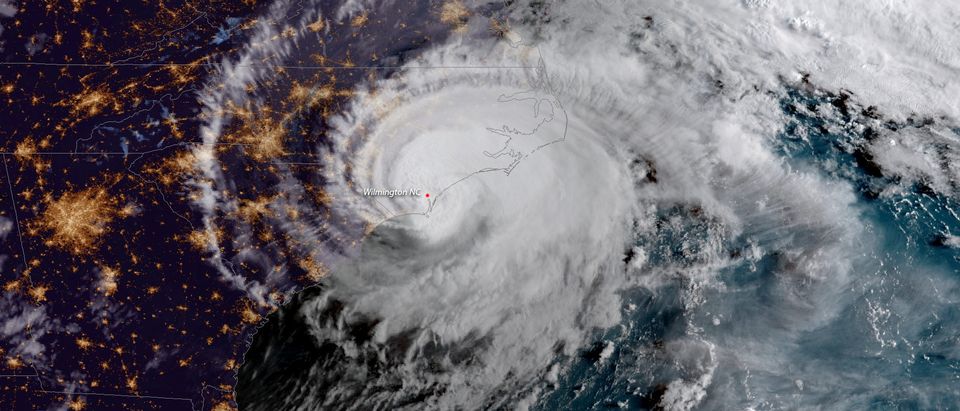- Hurricane Florence tracked mostly in “abnormally cool” waters, according to Cato Institute atmospheric scientist Dr. Ryan Maue.
- Data on Florence’s track contradicts claims that the storm was “supercharged” by global warming.
- Forecasters expected Florence to strengthen in warmer waters, but that didn’t happen.
Even before Hurricane Florence barreled into the North Carolina coast, a misleading claim about the storm and global warming echoed across the internet.
Florence made landfall in North Carolina as a Category 1 hurricane on Friday, but the day before, The New York Times published a video claiming the storm had formed in “unusually warm waters” in the Atlantic Ocean, heated up by man-made global warming.
In comparing Florence to last year’s Hurricane Harvey, The Times’ reporter said “both of these hurricanes formed in unusually warm waters.” That’s false, according to Cato Institute atmospheric scientist Ryan Maue.
“Ocean surface temperatures along Florence track were abnormally cool for most of its life-cycle partly due to the unusual, higher latitude of the storm,” Maue tweeted on Tuesday night. “The integrated [sea surface temperature] track-based anomaly averaged from Sept 4-11 was 0.6°C below 1985-2017 ‘normal.'”
Florence formed in colder than normal waters in the eastern Atlantic Ocean. Florence also reached major hurricane strength (Category 3 or higher) in cooler waters, before heading into warmer waters where it didn’t do what weather forecasters expected — it weakened and fell apart.
In fact, what’s amazing is how strong the storm got and how long it stayed together over “marginal” ocean temperatures, Maue tweeted. (RELATED: Hurricane Florence Dumped 13 TRILLION Gallons Of Rainfall On Carolinas, Virginia)
Florence ocean surface warmth analysis (Part 1)
The ocean surface temperatures beneath Hurricane #Florence on its trip from the chilly Eastern Atlantic to just past 60-degrees West Longitude –>
September 4-11thThis track coolest since 1996 … more typical of cold mid-1980s… pic.twitter.com/x7fNCMz2Fk
— Ryan Maue | weathermodels.com (@RyanMaue) September 18, 2018
Florence intensified from a Tropical Storm — the briefly reached Category 4 on Sept 5 before being sheared apart about 24-hours later.
The SST was only near 26°C on September 5th — 3rd coldest since 1985 — behind 1996 and 2000.
Florence overachieved over marginal SSTs. pic.twitter.com/qLF8B8Jqyh
— Ryan Maue | weathermodels.com (@RyanMaue) September 18, 2018
The National Hurricane Center initially forecast Florence to hit land at Category 3 or 4 strength on the Saffir-Simpson scale, making it a major hurricane at landfall. Forecasters likely expected the warmer waters close to the U.S. coast to intensify the storm.
Instead, Florence weakened as it approached the Carolinas, despite the warmer waters close to the coast. Florence made landfall as a Category 1 hurricane, though the storm still brought heavy rainfall and flooding across the southeast.
However, NYT’s video on Hurricane Florence ignored such data. Likewise, Pennsylvania State University climate scientist Michael Mann claimed warmer than normal water temperatures “supercharged” Florence.
Mann blamed an “ocean heat wave,” linking to a National Oceanic and Atmospheric Administration (NOAA) article published about one week before Florence made landfall.

However, the article Mann cited as evidence is referring to the warm coastal waters of New England and eastern Canada — hundreds of miles from Florence’s actual track.
But even the warmer waters near the U.S. coast were actually close to the 30-year average, Maue said.
Florence regained Category 4 strength of 120-knots late on September 10th over > 28°C sea-surface temperatures — but did NOT intensify further even though “much warmer” bathtub water was on track to North Carolina.
Florence expanded in size — but not max winds until landfall pic.twitter.com/varQwXpaK6
— Ryan Maue | weathermodels.com (@RyanMaue) September 18, 2018
Follow Michael on Facebook and Twitter
All content created by the Daily Caller News Foundation, an independent and nonpartisan newswire service, is available without charge to any legitimate news publisher that can provide a large audience. All republished articles must include our logo, our reporter’s byline and their DCNF affiliation. For any questions about our guidelines or partnering with us, please contact licensing@dailycallernewsfoundation.org.


